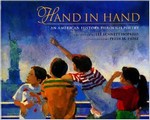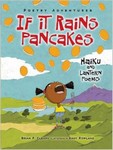Many children's book authors and illustrators visit schools, and when they do the eager students often ask a lot of questions. One of the most commonly asked questions is some version of "Where do your stories come from?" In today's picture book this question is answered in a clever and often amusing way.
Any Questions?
 Marie-Louise Gay
Marie-Louise GayPicture Book
For ages 7 and up
Groundwood, 2014, 978-1554983827
Marie-Louise Gay is a much loved author whose books have delighted children (and adults) for many years. When Marie-Louise goes to talk to children in schools and libraries, they do what all children do. They ask questions. A lot of questions. Often the children want to know about Marie-Louise and her life, and then there are the questions that pertain to her stories and how she creates them. One of those questions that is often asked is, “Where does a story start?”
A story always starts with a blank page. If you stare at the page long enough, “anything can happen.” You might think that a blank piece of white paper cannot possibly inspire anything, but this is not true. For example, it can give birth to a scene that is full of a snowstorm. If you start with a piece of paper that is old looking and has a yellow tinge to it then you might end up telling a story about a time when dinosaurs walked the earth. Blue paper can lead to an underwater adventure and green paper can be the backdrop for a story about a jungle.
Sometimes stories don’t start with a color at all. Instead, “words or ideas” come “floating out of nowhere.” Bit by bit pieces of paper with words and thoughts written on them are collected and sorted, and then they are joined by “little scribbles and doodles,” which is when the kernel of a story starts to grow. Of course, sometimes an idea pops up on the page that simply does not work at all. When this happens an author has to search around for something that does work, which can take a little (or even a lot) of time to happen. These things cannot be rushed though, and eventually the right piece of story comes along and the author is off and running.
In this wonderful picture book, Marie-Louise Gay explores the writing process, answering questions that children have asked her over the years. She shows us how a story is built, how it unfolds, and we see, right there on the pages, how she creates a magical story out of doddles, scraps of ideas, and tidbits of inspiration. The little children and animals characters who appear on the pages interact with the story, questioning, advising, and offering up ideas.
This is a book that writers of all ages will love. It is funny, cleverly presented, and it gives writers encouragement and support.








